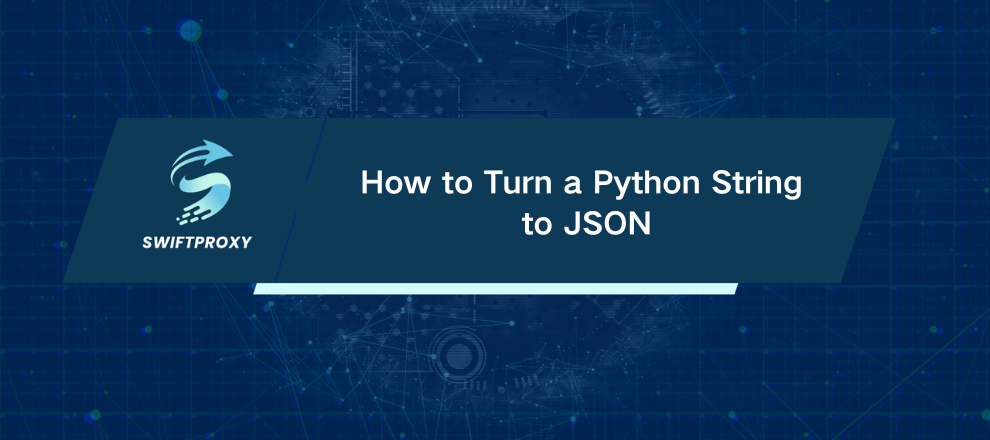How to Turn a Python String to JSON

Every day, thousands of web applications exchange data seamlessly, much of it in JSON format. If you've ever wondered how Python code communicates with APIs or stores structured data, understanding JSON is the first step. Converting a Python object to a JSON string may seem tricky at first, but with the right approach, it becomes straightforward and clear.
By the end of this guide, you'll know how to handle JSON like a pro, avoid common pitfalls, and make your Python applications communicate efficiently.
What Is JSON and Why You'll Use It
JSON, short for JavaScript Object Notation, is a lightweight and highly readable data format. Think of it as a universal language for structured information. You'll encounter it everywhere:
APIs powering your favorite apps.
Configuration files for web applications.
Data exchange between front-end and back-end systems.
Logging and monitoring outputs.
JSON objects map directly to Python dictionaries. That's why converting between Python objects and JSON strings is intuitive—and powerful. Once you grasp this, integrating APIs or managing configuration files becomes much smoother.
Transforming a Python String Into JSON
In Python, the json module is your tool for the job. To convert a Python object into a JSON string—a process called serialization—you'll use json.dumps().
Here's a practical example:
import json
user_data = {
"username": "sam_green",
"active": False,
"roles": ["viewer"]
}
json_output = json.dumps(user_data)
print(json_output)
Step by step:
Import the JSON module.
Define a Python dictionary with your data.
Call json.dumps() to convert the object into a JSON string.
Print it, and voila—a properly formatted JSON object:
{"username": "sam_green", "active": false, "roles": ["viewer"]}
Notice how Python's False becomes false. JSON has strict formatting rules, so this ensures compatibility with web applications and APIs.
Turning JSON into a Python Object
Turning a JSON string back into a Python object is just as simple. Use json.loads():
import json
json_string = '{"id": 101, "status": "active", "tags": ["urgent", "internal"]}'
ticket_info = json.loads(json_string)
print(ticket_info)
What happens here:
A valid JSON string is created.
json.loads() parses it into a Python dictionary.
You can now access it like any other Python object:
{'id': 101, 'status': 'active', 'tags': ['urgent', 'internal']}
Instantly, your JSON data is ready for use in scripts, APIs, or web applications.
Common Pitfalls and How to Avoid Them
Beginners often hit a few bumps when working with JSON. Here's what to watch out for:
Single Quotes Instead of Double Quotes
Wrong:
json_string = "{'key': 'value'}"
Correct:
json_string = '{"key": "value"}'
Unescaped Quotes
Wrong:
json_string = '{"quote": "He said "Hello""}'
Correct:
json_string = '{"quote": "He said \"Hello\""}'
Non-Serializable Objects
from datetime import datetime
obj = {"created_at": datetime.now()}
json.dumps(obj) # Raises TypeError
Make sure all values are JSON-compatible.
Malformed Nested Structures
Lists and dictionaries must nest properly. Invalid structures break APIs and scripts, so always validate before use.
Wrapping It Up
Converting between Python objects and JSON strings doesn't have to be intimidating. With json.dumps() and json.loads(), you can serialize and deserialize data efficiently. Pay attention to formatting, escape characters, and nested structures, and you'll avoid common errors.
Once you're comfortable with these basics, handling APIs, configuration files, or structured logging becomes second nature. Your Python scripts are now ready to speak JSON fluently.
Note sur l'auteur

Every day, thousands of web applications exchange data seamlessly, much of it in JSON format. If you've ever wondered how Python code communicates with APIs or stores structured data, understanding JSON is the first step. Converting a Python object to a JSON string may seem tricky at first, but with the right approach, it becomes straightforward and clear.
By the end of this guide, you'll know how to handle JSON like a pro, avoid common pitfalls, and make your Python applications communicate efficiently.
What Is JSON and Why You'll Use It
JSON, short for JavaScript Object Notation, is a lightweight and highly readable data format. Think of it as a universal language for structured information. You'll encounter it everywhere:
APIs powering your favorite apps.
Configuration files for web applications.
Data exchange between front-end and back-end systems.
Logging and monitoring outputs.
JSON objects map directly to Python dictionaries. That's why converting between Python objects and JSON strings is intuitive—and powerful. Once you grasp this, integrating APIs or managing configuration files becomes much smoother.
Transforming a Python String Into JSON
In Python, the json module is your tool for the job. To convert a Python object into a JSON string—a process called serialization—you'll use json.dumps().
Here's a practical example:
import json
user_data = {
"username": "sam_green",
"active": False,
"roles": ["viewer"]
}
json_output = json.dumps(user_data)
print(json_output)
Step by step:
Import the JSON module.
Define a Python dictionary with your data.
Call json.dumps() to convert the object into a JSON string.
Print it, and voila—a properly formatted JSON object:
{"username": "sam_green", "active": false, "roles": ["viewer"]}
Notice how Python's False becomes false. JSON has strict formatting rules, so this ensures compatibility with web applications and APIs.
Turning JSON into a Python Object
Turning a JSON string back into a Python object is just as simple. Use json.loads():
import json
json_string = '{"id": 101, "status": "active", "tags": ["urgent", "internal"]}'
ticket_info = json.loads(json_string)
print(ticket_info)
What happens here:
A valid JSON string is created.
json.loads() parses it into a Python dictionary.
You can now access it like any other Python object:
{'id': 101, 'status': 'active', 'tags': ['urgent', 'internal']}
Instantly, your JSON data is ready for use in scripts, APIs, or web applications.
Common Pitfalls and How to Avoid Them
Beginners often hit a few bumps when working with JSON. Here's what to watch out for:
Single Quotes Instead of Double Quotes
Wrong:
json_string = "{'key': 'value'}"
Correct:
json_string = '{"key": "value"}'
Unescaped Quotes
Wrong:
json_string = '{"quote": "He said "Hello""}'
Correct:
json_string = '{"quote": "He said \"Hello\""}'
Non-Serializable Objects
from datetime import datetime
obj = {"created_at": datetime.now()}
json.dumps(obj) # Raises TypeError
Make sure all values are JSON-compatible.
Malformed Nested Structures
Lists and dictionaries must nest properly. Invalid structures break APIs and scripts, so always validate before use.
Wrapping It Up
Converting between Python objects and JSON strings doesn't have to be intimidating. With json.dumps() and json.loads(), you can serialize and deserialize data efficiently. Pay attention to formatting, escape characters, and nested structures, and you'll avoid common errors.
Once you're comfortable with these basics, handling APIs, configuration files, or structured logging becomes second nature. Your Python scripts are now ready to speak JSON fluently.

















































